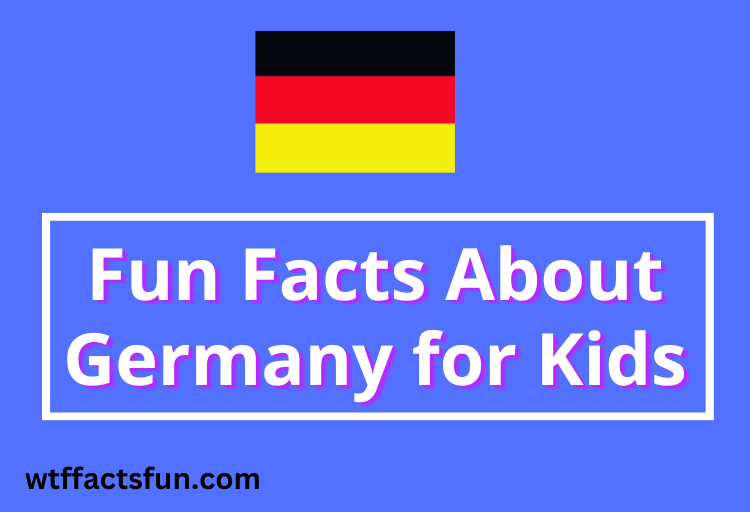
Table of Contents
- 1 Fun Facts About Germany for Kids
- 2 1. Germany Borders
- 3 2. Germany’s most populous city
- 4 3. Germanic Tribes
- 5 4. Unification of Germany
- 6 5. German Revolution of 1918–1919
- 7 6. West Germany
- 8 7. Germany’s Economy
- 9 8. Germany Peaceful Country
- 10 9. Germany World Heritage Sites
- 11 10. Germany’s History
- 12 11. Nazi Germany
- 13 12. Germany Weather
- 14 13. Germany’s Constituent states
- 15 14. Germany’s military
- 16 15. Germany, Tourist place
Fun Facts About Germany for Kids
Fun Facts About Germany for Kids: Central European nation, officially known as the Federal Republic of Germany. It has the second-highest population in Europe, behind Russia, and is the most populous EU member. Between the Baltic and North Seas to the north and the Alps to the south, Germany occupies a land area of 357,022 square kilometres and is home to about 84 million people throughout its 16 member states.
1. Germany Borders
Denmark is to the north, Poland and the Czech Republic are to the east, Austria and Switzerland are to the south, and France, Luxembourg, Belgium, and the Netherlands are to the west of Germany.
2. Germany’s most populous city
Berlin, the nation’s capital and most populated city, Frankfurt, its financial hub, and the Ruhr, its largest metropolitan area.
3. Germanic Tribes
The northern regions of current Germany have been inhabited by various Germanic tribes since classical antiquity. An inventory of ancient Germanic cultures, tribal affiliations, and other alliances of Germanic tribes and civilisations are included in the term “old Germanic peoples.”
4. Unification of Germany
The process of creating the modern German nation-state with federal features based on the idea of Lesser Germany (one without a multinational Austria) began on August 18, 1866, when the North German Confederation Treaty was adopted. Initially, a Prussian-dominated military alliance, the North German Confederation was later strengthened with the adoption of the North German Constitution.
5. German Revolution of 1918–1919
The Weimar Republic, often known as the German Revolution or November Revolution, was a democratic parliamentary republic that was established in place of the German federal constitutional monarchy at the conclusion of the First World War. The Weimar Constitution was ratified in August 1919, ending the revolutionary era, which began in November 1918.
6. West Germany
The Federal Republic of Germany, which existed from its founding on May 23, 1949, and the reunification of Germany on October 3, 1990, is referred to informally as West Germany. Germany’s western region, along with West Berlin’s surrounding area, belonged to the Western Bloc during the Cold War.
7. Germany’s Economy
With the largest economy in Europe, the fourth-largest nominal GDP, and the fifth-largest PPP, Germany is a major power with a robust economy. It ranks as the third-largest exporter and importer in the world and is a major force in the industrial, scientific, and technological fields.
8. Germany Peaceful Country
As a highly developed nation, it offers social security, a universal health care system, environmental protections, and tuition-free university education, and is recognised as the sixteenth most peaceful nation in the world. It ranks ninth on the Human Development Index.

9. Germany World Heritage Sites
Germany is a member of the OECD, the G7, the G20, the Council of Europe, the European Union, NATO, and the United Nations. The third-highest number of UNESCO World Heritage Sites are found there.
10. Germany’s History
The Danuvius Guggenmosi, a group of early hominins who lived in Germany around 11 million years ago, is thought to have been among the first creatures to stand up straight. At least 600,000 years ago, there were ancient humans living in Germany. In the Neander Valley, the first fossil of an extinct modern human was found.
11. Nazi Germany
Following a special election in 1932, Adolf Hitler’s Nazi Party emerged as the dominant force in the Reichstag, and on January 30, 1933, Hindenburg named Hitler the chancellor of Germany. Basic civil rights were repealed by decree following the Reichstag fire, and the first Nazi concentration camp was established. The Enabling Act, which replaced the constitution on March 23, 1933, gave Hitler unchecked legislative authority, ushering in the Nazi era in Germany.
12. Germany Weather
The majority of Germany has a temperate climate, which ranges from continental in the east and southeast to oceanic in the north. Summers can range from hot and dry to cool and rainy, while winters range from frigid in the Southern Alps to cool and are typically gloomy with little precipitation. Westerly winds dominate in the north, bringing moist air from the North Sea that lowers temperatures and increases precipitation. On the other hand, temperatures in the southeast are more extreme.
13. Germany’s Constituent states
Germany is a federation made up of sixteen member states, referred to as Länder together. Each state has a unique constitution and enjoys a high degree of internal autonomy. Germany is currently divided into 401 municipal districts, 294 of which are rural and 107 of which are urban.
14. Germany’s military
The Army and special forces KSK, Navy, Air Force, Joint Medical Service, Joint Support Service, Cyber and Information Domain Service, and other branches make up Germany’s Bundeswehr. German military spending is the eighth-highest in the world in terms of absolute numbers.
15. Germany, Tourist place
With 37.4 million visitors as of 2017, Germany ranked tenth among all nations. The Brandenburg Gate, the Reichstag, the Dresden Frauenkirche, Neuschwanstein Castle, Heidelberg Castle, the Wartburg, and Sanssouci Palace are some of the most well-known and often visited sites in Germany. The second-most visited theme park resort in Europe is Europa Park in the vicinity of Freiburg.
Final words:
We hope you liked our post, “Fun Facts About Germany for Kids.” You can share this post with your friends and relatives so they can also learn something new from it.
Read also:
Top 12 Fun Facts About Polar Bears for Kids
Top 15 Facts About Amphibians for Kids